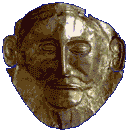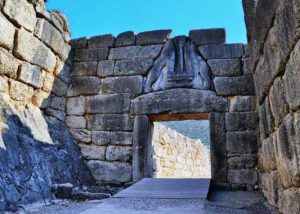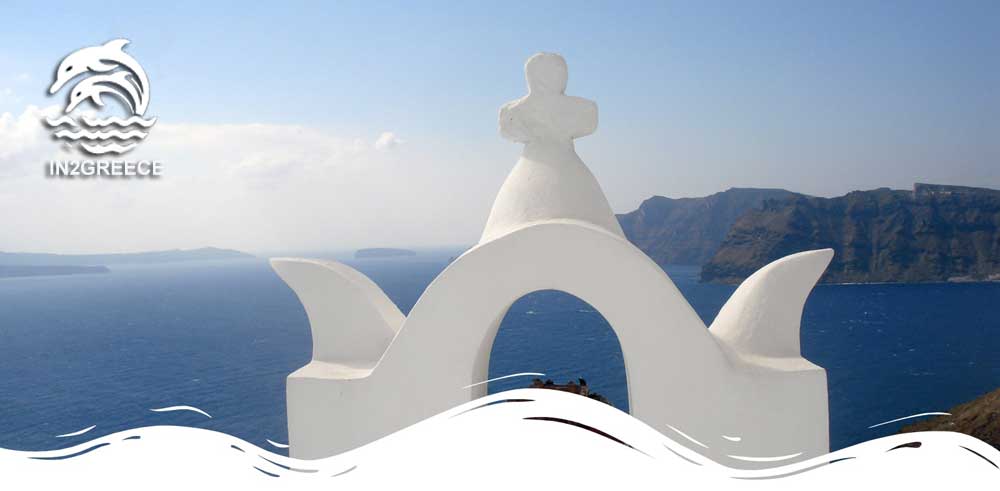Information about Mycenae
Mycenae, this is an eerie place where a curse once lay – tormenting a whole royal family with a cruel destiny. Mycenae is a fascinating place, and walking through the Lions’ Gate you become part of the past, and it is not hard to imagine the drama that once took place here. Myth and history intertwine, leaving only the ruins as a memory..
Mythology:

But there were many events preceding the above. The founder of the Mycenaean kingdom was the hero Perseus. When the last descendant of him, king Eurystheus – the one who had ordered the labours from Heracles – died, the people voted for Atreus to be their new king. When Atreus brother Thyestes seduced his wife, he took his revenge by killing Thyestes two sons, and then serving them to their father. Filled with rage and disgust, Thyestes cursed Atreus and his children, and only unhappiness was to haunt them thereafter.
Atreus two sons were Agamemnon and Menelaus. Agamemnon, who was the oldest, inherited the kingdom of Mycenae, and Menelaus became king of Sparta. They married the two sisters Clytemnestra and Helen respectively, and were at first very happy. This was not to last, though.
When the Trojan prince Paris was called to decide who of the three goddesses Hera, Athena and Aphrodite was the most beautiful, they each tried to bribe him. Aphrodite had promised him the most beautiful woman in Greece, and when Paris chose her, Helen was his prize. With the help of the goddess, Helen went to Troy with Paris, leaving the outrages Menelaus to declare war on the Trojans. He asked his brother for help, and together they raised an army of Greek kings and heroes.

Aegisthus was the result of Thyestes incestuous rape of his own daughter Pelopia. He had killed Atreus and ruled Mycenae with Thyestes for some time, but when Thyestes died, the throne was taken by Agamemnon. Filled with hate against Agamemnon he decided to do everything in his power to seize the throne, and when the king had to leave for the Trojan War, he saw his chance.
At first, Clytemnestra resisted him, but when Aegisthus realized the reason was the singer, he took him away from there. The couple then ruled Mycenae in the king’s absence, and as soon Agamemnon had returned, they murdered him. Agamemnon’s son Orestes was to revenge his fathers’ death by killing his mother and her lover, and after a long time of persecution by the Furies he was finally cleared of the crime.
Orestes then married Menelaus and Helen’s daughter Hermione, and so the kingdom of Mycenae and Sparta were united. After some time Heracles’ descendants came and overthrew the king, and so, the cycle was complete.
History
The site of Mycenae was first excavated in 1874 by Heinrich Schliemann, the German amateur archaeologist who had also discovered the ruins of Troy. There is evidence that it was already inhabited in the 5th Millennium BC, but its true greatness came during the Late Bronze Age (1400-1200) when it was a strong military and economical power. Because of its’ outstanding position, it was to name the whole civilization in Greece of this time.
It was now that the Lions’ Gate was built, and in the whole area new buildings were added or old ones repaired. A magnificent palace was constructed, and the site was surrounded by great walls. The Treasury of Atreus was also built, a grave chamber shaped as a dome. The city was crowned with an acropolis even before the Mycenaean civilization, and the location of the site was very strategic.
In the surroundings there were many buildings from the ancient city: houses, bakeries, workshops, a granary etc. There was also an extensive plumbing system that provided Mycenae with fresh drinking water.
Even though the archaeological evidence speaks against that the famous golden mask of Agamemnon actually belonged to the famous king, it is one of the most famous findings of the ancient world. It is on display in the National Archaeological Museum of Athens, along with several other objects from the excavations in Mycenae. Several of the tombs in Mycenae have also been named after the family of Atreus. There is Agamemnon’s tomb, the tomb of Clytemnestra and Aegisthus’ tomb at the so called Grave Cycle B.
Mycenae was almost completely destroyed by a fire in the 12th century. The Mycenaean civilization declined, but the area was still inhabited. It is believed that it was abandoned in the 3rd century AD.
The Museum
The findings from Mycenae can be viewed in the National Archaeological Museum of Athens, but all over Greece there are also smaller museums that hold Mycenaean objects.
Getting There
Mycenae is situated on the Peloponnese in the prefecture of Argolis. There are several buses that go there, and the best connections are from Athens. You can either go on your own or on one of the many organised excursions that are offered by travel agencies. (map of Mycenae)
